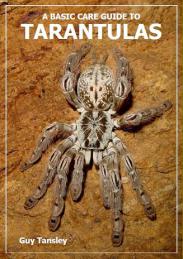
Avicularia, Lamarck, 1818, spp. are an ideal 'first arboreal' species. They are not overly aggressive, but are quite nervous. There are several species regularly available but their captive
care is similar. All breed fairly easily in captivity and the male can be allowed to stay with the female for several nights to a ensure successful mating. Incubation times vary depending on
conditions of temperature etc., but when the young emerge they can be the complete colour negative to the adults having an overall pink body and black toes. Fast growing, they can reach full size
within 18 months. Observations of Avicularia spp. in their natural environment (Peru) show that in highly populated areas most of the largest trees are home to a mature female. These areas of rainforest are flooded
for up to eight months of the year and specimens can been seen on trees after dusk in their characteristic hunting position. These spiders are also known to be able to 'swim' away from potential
attackers, using air trapped between the many bristles covering the body that allows them to float on the waters surface. Females are present all year round and males appearing around the dry season
of October. Known in Spanish as dedo rosado (pink toe), any Avicularia spp. is a welcome addition to any collection. All have a patch of urticating hair on the
abdomen but it is of the non-airborne type and rarely used. A typical arboreal set-up is ideal (tall container, moist substrate and piece of cork bark against one side as a retreat) but good
ventilation is considered essential for captive Avicularia spp. See here for more information on housing. There is some confusion over correct identification of most species so caution is advised when
attempting to breed them, making sure that both male and female are of the same species. Once a revision is done on the genus, it is commonly thought that most will be colour/regional variations of
the same species. As with many arboreal genera, lifespan is shorter than that of terrestrial species and Avicularia spp. usually live around 7 - 10 years.
Some are considered social and will tolerate each other in communal set-ups in captivity if enough food is available.
Common species in captivity:
A. avicularia - (Linnaeus, 1758) (Costa
Rica to Brazil)
The original pink toe tarantula, a widespread species from the northern half of South America but also found in Trinidad. Arboreal in nature it has also benefited somewhat from human habitations and
it's tubular silken retreats can be found in the roof eves of local houses. Spiderlings are negative in colouration to the adults having pink legs and black toes. The abdomen has dark chevrons that
eventually fade as the spider matures. Adults typically reach around 5" legspan.
A. juruensis - Mello-Leitão, 1923
(Brazil)
Commonly called the yellow banded, A. juruensis is another striking species and fairly easy to maintain in captivity. There is some confusing over correct ID with this species (often sold
as A. aurantiaca or A. magdalenae) but adults tend to be more olive green coloured whereas A.
aurantiaca is more gold. Spiderlings and adults are still relatively rare.
A. minatrix - Pocock, 1903
(Venezuela)
One of the smallest species (around 4" legspan) in the genus but also one of the easiest to distinguish. The abdomen unusually retains it's spiderling colours and pattern and the rest of the body is
clothes with pink hairs.
A. purpurea - Kirk, 1990 (Ecuador)
Another smaller than average species reaching around 5" in legspan, A
purpurea is attractively coloured in various shades of purple and off-white toes.

